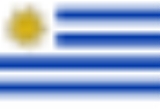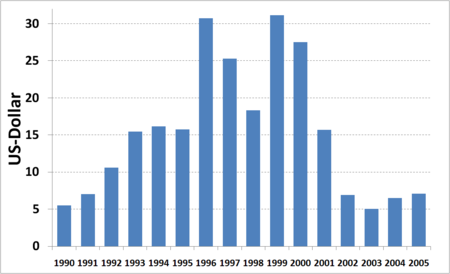
Water supply and sanitation in Uruguay
Encyclopedia
| Uruguay Uruguay Uruguay ,officially the Oriental Republic of Uruguay,sometimes the Eastern Republic of Uruguay; ) is a country in the southeastern part of South America. It is home to some 3.5 million people, of whom 1.8 million live in the capital Montevideo and its metropolitan area... : Water and Sanitation |
|---|
}}
|-
!align="center" bgcolor="lightblue" colspan="3"|Data
|-
!align="left" valign="top"|Water coverage (broad definition)
|valign="top"| 100%
|-
!align="left" valign="top"|Sanitation coverage (broad definition)
|valign="top"| 100%
|-
!align="left" valign="top"|Continuity of supply (%)
|valign="top"| 100%
|-
!align="left" valign="top"|Average urban water use (l/c/d)
|valign="top"| 183
|-
!align="left" valign="top"|Average urban water and sewer bill
|valign="top"| US$ 22/month (2007)
|-
!align="left" valign="top"|Share of household metering
|valign="top"| 93%
|-
!align="left" valign="top"|Share of collected wastewater treated
|valign="top"| n/a
|-
!align="left" valign="top"|Annual investment in WSS
|valign="top"| n/a
|-
!align="left" valign="top"|Share of self-financing by utilities
|valign="top"| nil
|-
!align="left" valign="top"|Share of tax-financing
|valign="top"| n/a
|-
!align="left" valign="top"|Share of external financing
|valign="top"| n/a
|-
!align="center" bgcolor="lightblue" colspan="3"|Institutions
|-
!align="left" valign="top"|Decentralization to municipalities
|valign="top"| No
|-
!align="left" valign="top"|National water and sanitation company
|valign="top"| Yes
|-
!align="left" valign="top"|Water and sanitation regulator
|valign="top"| Yes, multi-sector
|-
!align="left" valign="top"|Responsibility for policy setting
|valign="top"| Ministry of Housing, Land Management and Environment
|-
!align="left" valign="top"|Sector law
|valign="top"| No
|-
!align="left" valign="top"|Number of urban service providers
|valign="top"| 1
|-
!align="left" valign="top"|Number of rural service providers
|valign="top"| n/a
|-
|}
Uruguay
Uruguay
Uruguay ,officially the Oriental Republic of Uruguay,sometimes the Eastern Republic of Uruguay; ) is a country in the southeastern part of South America. It is home to some 3.5 million people, of whom 1.8 million live in the capital Montevideo and its metropolitan area...
is the only country in Latin America that has achieved quasi universal coverage of access to safe drinking water supply
Water supply
Water supply is the provision of water by public utilities, commercial organisations, community endeavours or by individuals, usually via a system of pumps and pipes...
and adequate sanitation
Sanitation
Sanitation is the hygienic means of promoting health through prevention of human contact with the hazards of wastes. Hazards can be either physical, microbiological, biological or chemical agents of disease. Wastes that can cause health problems are human and animal feces, solid wastes, domestic...
(for water access see and for sanitation access see). Water service quality is considered good, with practically all localities in Uruguay receiving disinfected water on a continuous basis. 70% of wastewater collected by the national utility was treated. Given these achievements, the government's priority is to improve the efficiency of services and to expand access to sewerage, where appropriate, in areas where on-site sanitation is used.
Access
Water and sanitation coverage in Uruguay (2004)| Urban (93% of the population) | Rural (7% of the population) | Total | ||
|---|---|---|---|---|
| Water | Broad definition | 100% | 100% | 100% |
| House connections | 97% | 84% | 96% | |
| Sanitation | Broad definition | 100% | 99% | 100% |
| Sewerage | 81% | 42% | 78% | |
Source: WHO
Who
Who may refer to:* Who , an English-language pronoun* who , a Unix command* Who?, one of the Five Ws in journalism- Art and entertainment :* Who? , a 1958 novel by Algis Budrys...
/UNICEF Joint Monitoring Programme (JMP/2006). Data for water and sanitation based on the WHO World Health Survey (2003).
Water use
Per capita water production is high at 411 liter/capita/day (90.4 Imperial gallons/c/d, 108.6 US gallons/c/d). Even after taking into account non-revenue water of 54%, at 183 liter/capita/day (40.3 Imperial gallons/c/d, 48.3 US gallons/c/d) it is still higher than in many European countries. However, water use is much lower than in neighboring Argentina, where metering is not widespread, while in Uruguay 96% of water connections were metered in 2004.History and recent developments

Maldonado Department
The Maldonado Department , with an area of and 140,192 inhabitants, is located to the southeast of Uruguay. Its capital is Maldonado.-Geography and climate:...
, home to many tourist resorts and the town Punta del Este
Punta del Este
Punta del Este is a resort town on the Atlantic Coast in the Maldonado Department of southeastern Uruguay. It is located on the intersection of Route 10 with Route 39, directly southeast of the department capital Maldonado and about east of Montevideo...
. The first concession was granted in 1993 to Aguas de la Costa, a Uruguayan firm which later became majority-owned by Aguas de Barcelona, itself a subsidiary of the French firm Suez. The second concession was granted in 2000 to URAGUA, a subsidiary of Aguas de Bilboa of Spain.
To complement the policy of private sector participation, the government created in 2002 the utility regulatory agency URSEA covering the power and water sector.
Nevertheless, the private concessions remained contentious. Following a vigorous campaign against them and allegations of overcharging and poor service quality, Parliament passed a constitutional amendment in October 2004 prohibiting any form of private sector participation in the water sector. As a result, the concession of URAGUA was withdrawn in the same year.
In 2005 the government passed law 17.930 with the objective of improving the effective participation of users and civil society in planning, management and control of activities in the sector. For that purpose the law established a water and sanitation directorate (DINASA) in the Ministry of Housing and Environment, as well as a Water and Sanitation Advisory Commission (COASAS).
Meanwhile, the Uruguayan and foreign owners of Aguas de la Costa refused to yield to demands for nationalization. In 2006 the government bought the shares held by Aguas de Barcelona. From then on the enterprise operated as a mixed public-private enterprise with a majority public shareholding. In 2009 the company became one hundred percent owned by the State.
Responsibility for water supply and sanitation
The state owned national utility, Administración de las Obras Sanitarias del Estado (OSE) provides water and sewer services to all of Uruguay with the exception of MontevideoMontevideo
Montevideo is the largest city, the capital, and the chief port of Uruguay. The settlement was established in 1726 by Bruno Mauricio de Zabala, as a strategic move amidst a Spanish-Portuguese dispute over the platine region, and as a counter to the Portuguese colony at Colonia del Sacramento...
, where the municipality provides sewerage and OSE provides water services only. OSE serves 330 localities with 2.8 million inhabitants with water services and 152 localities with 0.5 million inhabitants with sewer services. It had 4,362 employees in 2004.
To enhance sector performance, new institutions have been recently established, including: the Regulatory Entity for Energy and Water (URSEA); the National Directorate of Water and Sanitation (DINASA) in the Ministry of Housing, Land Management and Environment, responsible for creating national sector policies on WSS; and the Advisory Commission on Water and Sanitation (COASAS).
The Government of Uruguay intends to establish a comprehensive legal and regulatory framework for the water supply and sanitation sector through a new law. It also plans to develop a policy on appropriate sanitation standards and to further improve the efficiency of OSE by stimulating internal competition and reducing unaccounted for water. Concerning internal competition, OSE has introduced an internal benchmarking
Benchmarking
Benchmarking is the process of comparing one's business processes and performance metrics to industry bests and/or best practices from other industries. Dimensions typically measured are quality, time and cost...
system comparing the utility’s performance across 21 cities based on 9 service quality indicators.
Economic efficiency
Between 1999 and 2005 OSE successfully increased labor productivityLabor productivity
Workforce productivity is the amount of goods and services that a worker produces in a given amount of time. It is one of several types of productivity that economists measure. Workforce productivity can be measured for a firm, a process, an industry, or a country...
from 5.6 employees/1000 connections to 4.5, decreased operating costs from US$0.98/m³ (US$0.75/cu yd) to US$0.71/m³ (US$0.54/cu yd); and increased operating margin
Operating margin
In business, operating margin — also known as operating income margin, operating profit margin and return on sales — is the ratio of operating income divided by net sales, usually presented in percent....
s from 35% to 42%. However, OSE’s performance continues to present areas of inefficiency. Reducing unaccounted for water, which remains around 54%, will continue to require a concerted effort.
Tariffs and affordability
Water and sewer tariffs charged by OSE differ depending on the category of users, with lower tariffs for residential users than for other users (commercial, industrial, official and public enterprises). Water and sewer tariffs in Uruguay have increased substantially since 1995. For example, a typical residential water bill (20 m³/month, 700 cu ft/month) for OSE consumers increased from the equivalent of 56 Pesos/month (US$9.50) in 1995 to 207 Pesos/month (US$18.20) in 2001, a 93% increase in US dollar terms in six years. Tariffs were further increased so that a typical residential bill reached 431 Pesos/month in 2003. But due to the massive devaluation of 2001 the US dollar equivalent of the monthly bill decreased to US$15/month. In 2007 a monthly residential water bill was estimated to be at least 568 Pesos, equivalent to more than US$22/month.Given that the average monthly income of a household in the two lowest income quintiles (a lower-middle income family) was about the equivalent of US$190 in 2003, water and sewer tariffs accounted for almost 8% of their income, an extraordinarily high percentage, which has probably further increased since then. Despite their very high levels, these tariffs are not subject to much public protest or complaints.

Investments and financing
The national water and sewer company Administración de las Obras Sanitarias del Estado (OSE), which has been created in 1952, does not receive direct subsidies from the Government. OSE finances its investments from internal revenues and loans. However, OSE’s financial health had been in decline during the 1990s and early 2000 due to high levels of operational inefficiency, thereby threatening OSE’s ability to carry out future required investments. OSE’s operating performance and financial health have since begun improving.The total expenditure of OSE between 1990 and 2005 was US$797 million, which is on annual average 0.24% of the Uruguayan GDP
Gross domestic product
Gross domestic product refers to the market value of all final goods and services produced within a country in a given period. GDP per capita is often considered an indicator of a country's standard of living....
or US$15.3 per capita. The annual investment was highest at the end of the 1990s, reaching US$30.8 in 1996 and US$31.2 per capita in 1999. Since 2001, it fell back to only US$5.1 per capita in 2003. The average annual investment per capita between 1997 and 2003 was higher than in other Latin American countries like Argentina, Peru, Colombia and Mexico.

